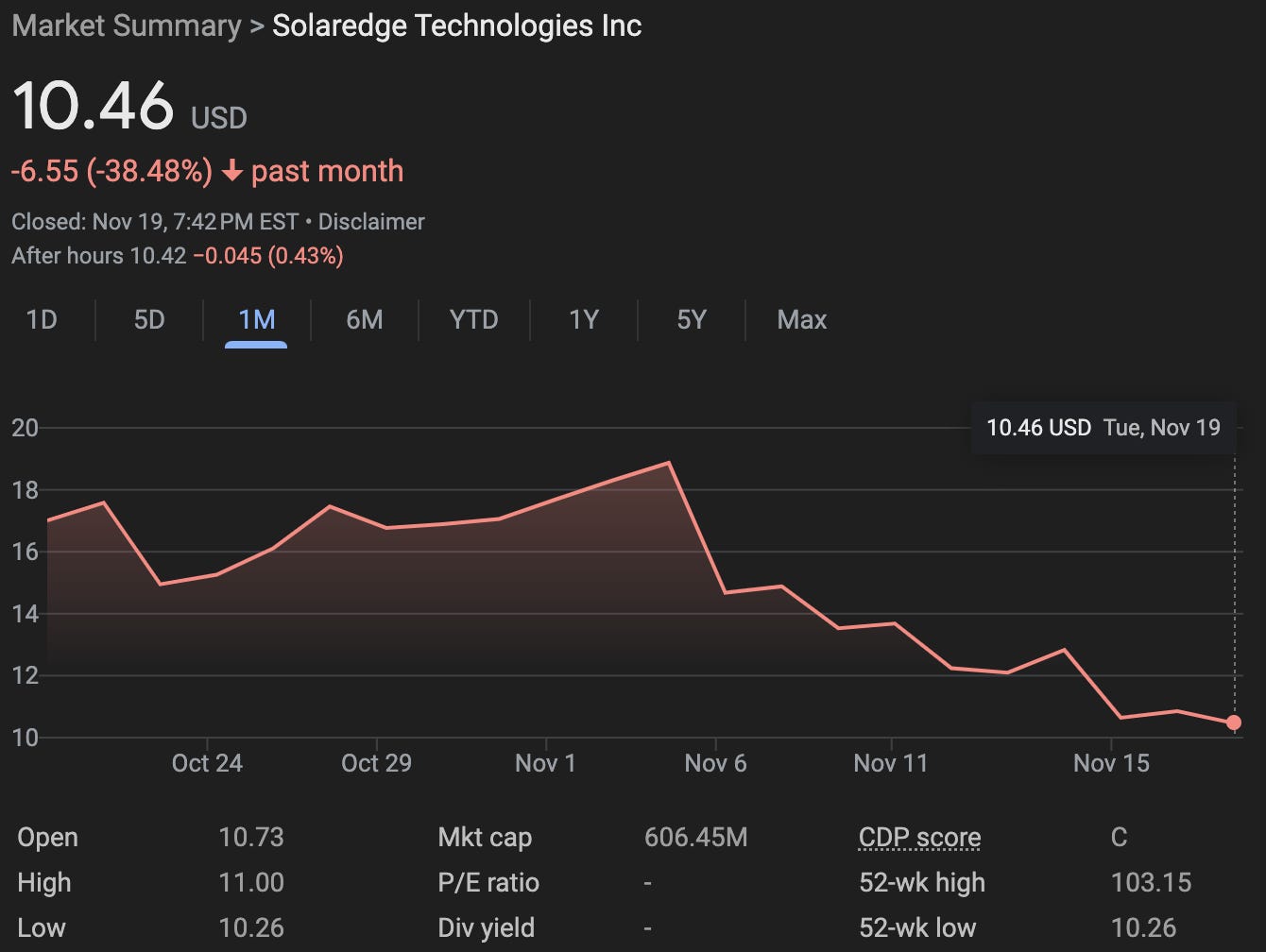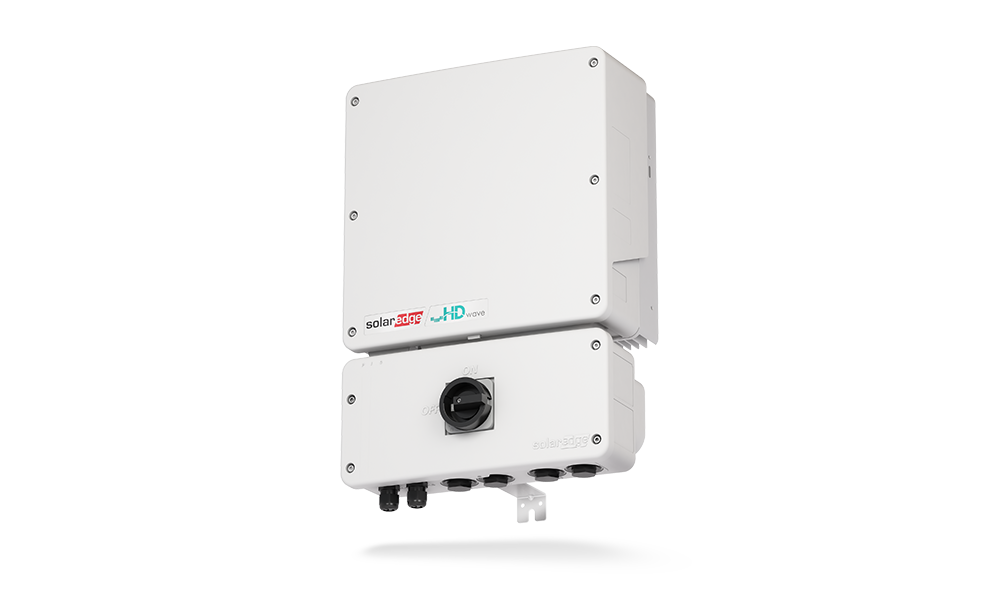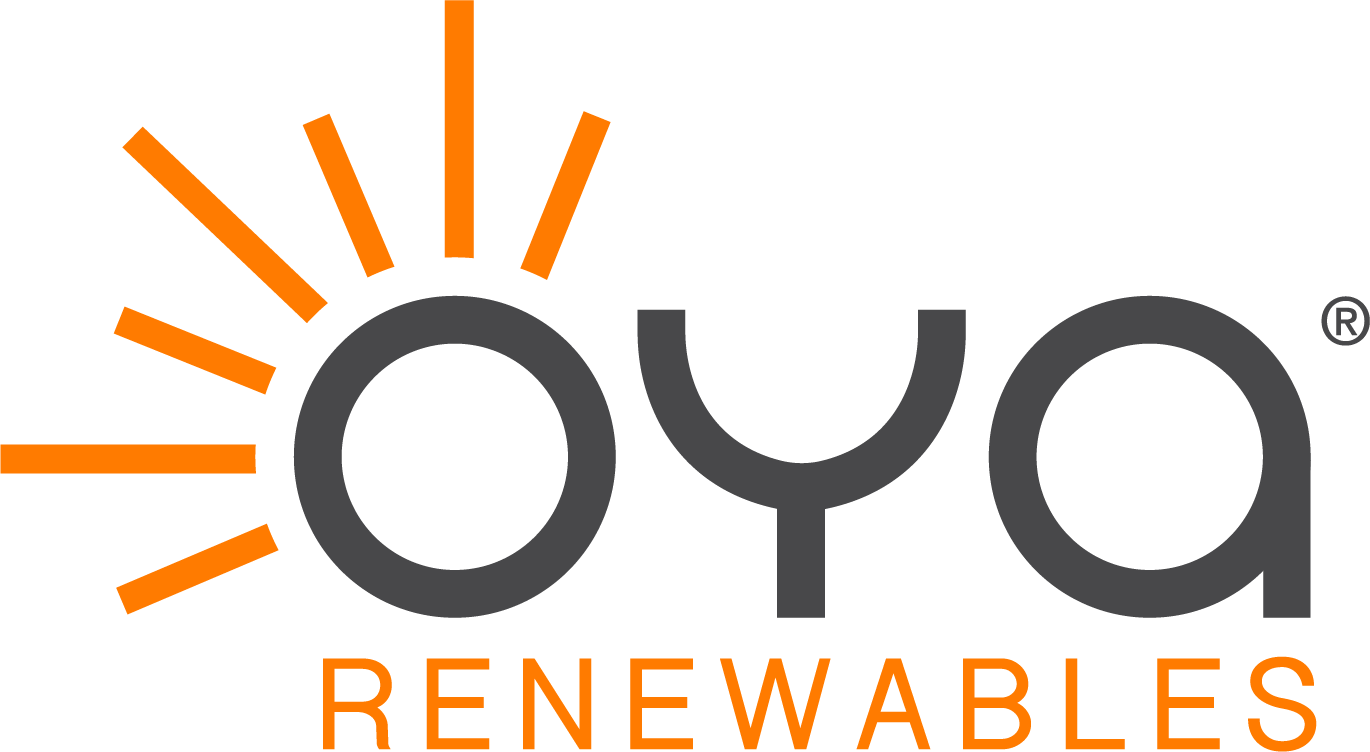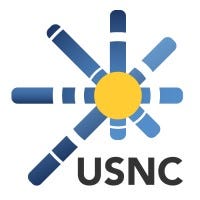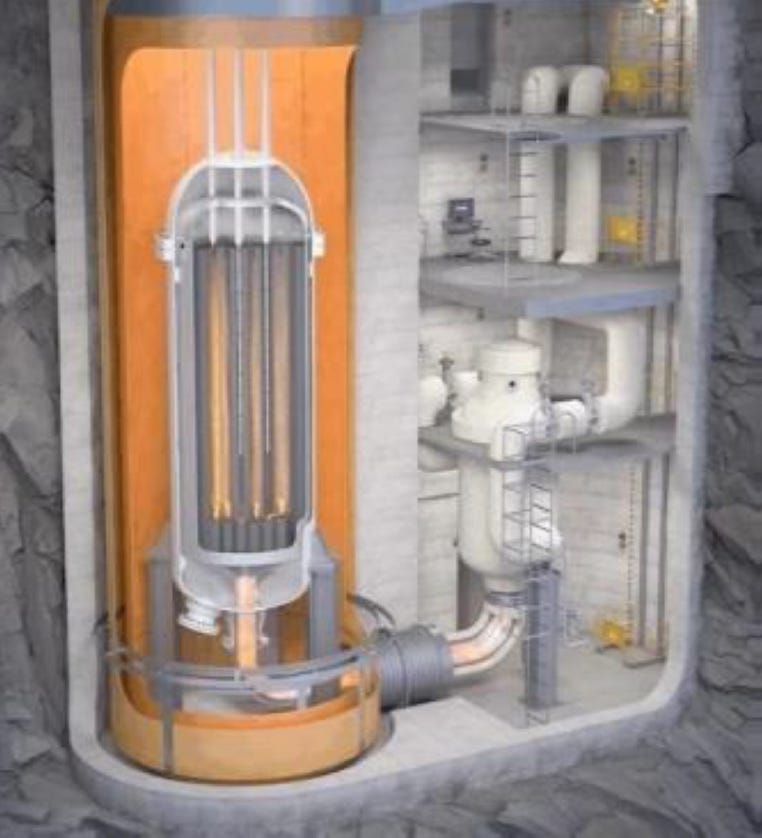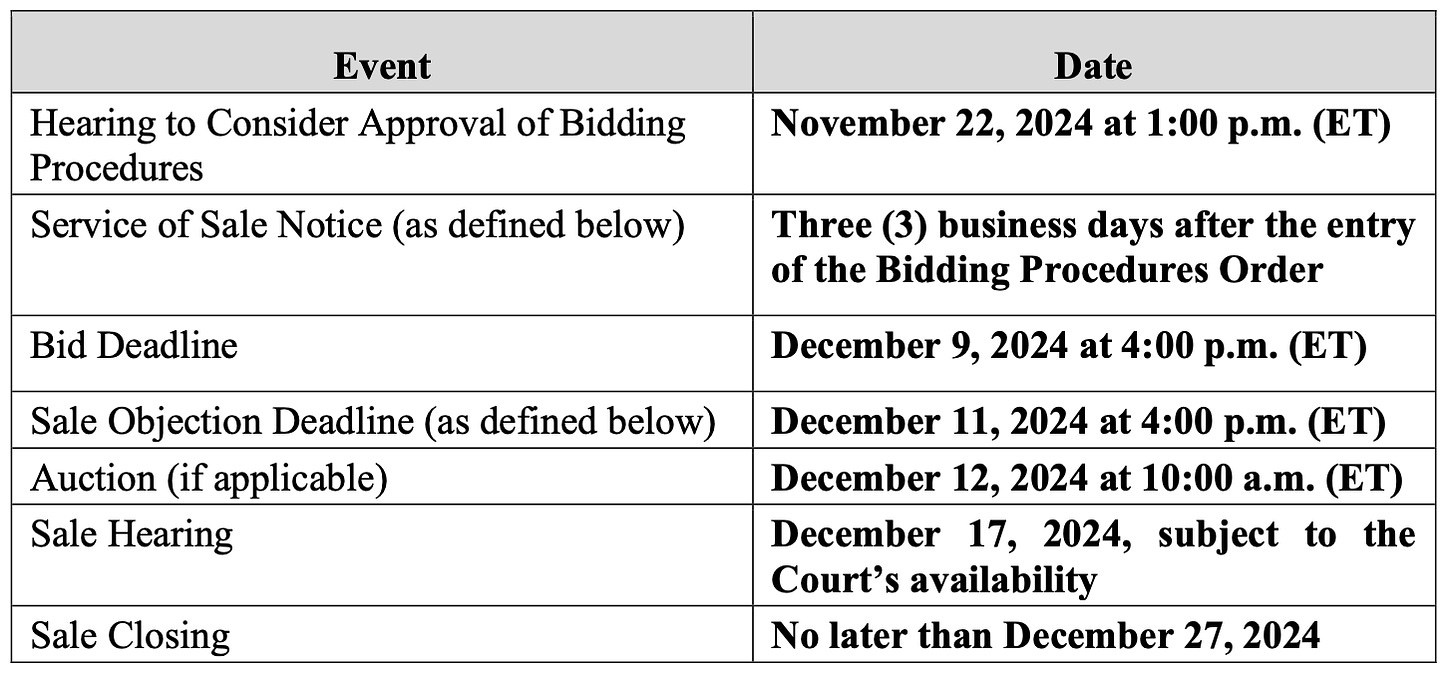ICYMI, we rejuvenated our stalled “Notice of Appearance” segment last Wednesday. Check it out here:
You’ll note that there’s a discussion of solar distress therein — a subject we’ll revisit today.
But solar is just one form of energy. There’s also the nuclear variety. And so we’ll spend a few moments discussing a recent nuclear name today as well.
Of course, let’s be real about sh*t for a moment: the RX industry tends to be rather insular and so the only form of energy people are going to want to discuss this particular morning is “BDE” — precisely what Latham & Watkins LLP (“Latham”) is bringing to the table as ‘24 winds to a close. The firm simultaneously poached four restructuring partners from two competing firms — three from Weil Gotshal & Manges LLP (“Weil”)(Ray Schrock, Candace Arthur, Alex Welch) and one from Paul Weiss Rifkind Wharton & Garrison LLP (“Paul Weiss”)(Andrew Parlen) — in an effort to give Kirkland & Ellis LLP (“Kirkland”) a run for its money.
Latham’s ‘24 is littered with a decent smattering of company-side names thus far — Robertshow US Holding Corp., JOANN Inc., 2U Inc., Afiniti Inc., and to some degree, Vroom Inc. For its part, Kirkland has had Careismatic Brands LLC, Sientra Inc., Invitae Corporation, Thrasio Holdings, Express Inc., Appgate Inc., Vyaire Medical Inc., Sunpower Corp., Wheel Pros, Digital Media Solutions Inc., Tupperware Brands Corp., Vertex Energy, Accuride Corp., and American Tire Distributors Inc. Weil has had Terraform Labs Pte. Ltd., Cano Health Inc., Steward Health Care System LLC, Mobileum Inc., DRF Logistics LLC, and AIO US Inc. Paul Weiss, meanwhile, had Hornblower Holdings LLC and lucked into Enviva Inc. once that case went dramatically sideways. Let’s break out the calculator:
Kirkland 14 > Weil 6 > Latham 5 > Paul Weiss 2. Clearly Latham’s brass is of the view that they’ll be some tightening of the spread with this splash of personnel. To which we say, “you come at the king, you best not miss.”
⚡️Update: Solaredge Technologies Inc. ($SEDG)⚡️
We last mentioned Solaredge Technologies Inc. ($SEDG) in our solar industry focused edition:
In it, we mentioned that the company let go 400 employees and was reeling from the chapter 7 bankruptcy of a major customer.
Well SEDG recently reported earnings and…
… it got absolutely crushed.
First — since we didn’t do it in our last piece — a brief overview of the business. SEDG is a provider of inverters, specifically string inverters.
Basically, these things:
These astronaut-pack-looking contraptions are mounted to the wall of your home in order to convert the direct current (“DC”) power captured from your solar panels into alternating current (“AC”) power. AC electricity is what your house uses to power your everyday needs.
As you can imagine, the company has been struggling amidst the overall decline in the solar market. It’s been so bad that gross margins have started to tank into negative territory.
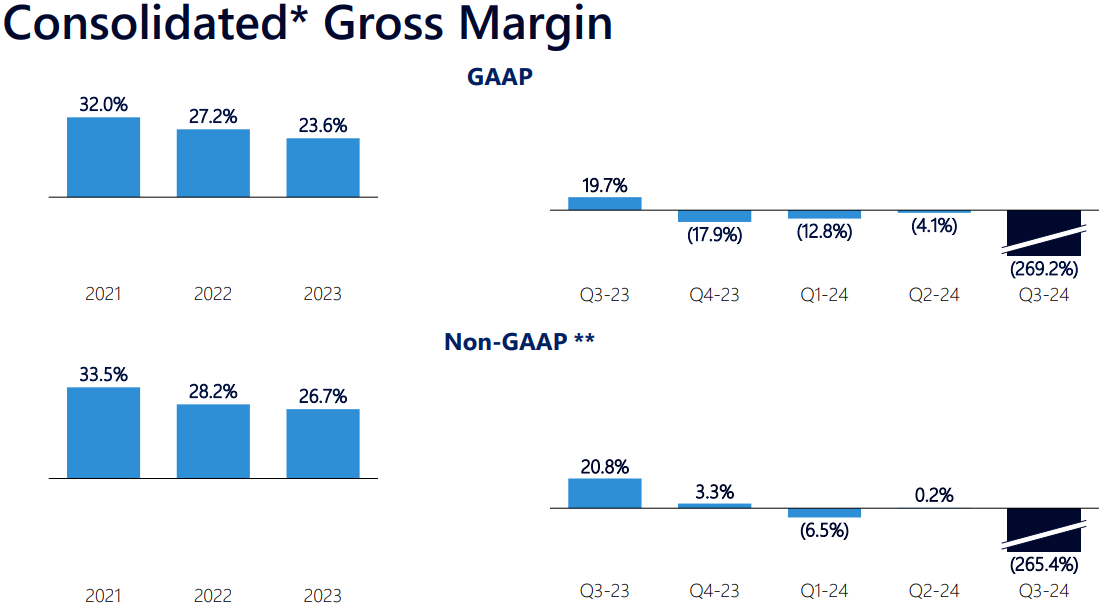
The days of 30%+ gross margins are no more as competition in (a commoditized) industry ramps up.
For 3Q’24, the company reported revenues of $260.9mm, down 63% YoY, a non-GAAP operating loss of $808mm, and a non-GAAP net loss per share of $15.33. SEDG also booked a massive $1b asset impairment charge. $612mm of that is attributed to an inventory write-down due to the company’s aggressive price reductions in an attempt to recapture market share (this also explains the collapsing gross margin). Management is guiding to revenues of $190mm and a non-GAAP gross margin of 2% for 4Q’24.
When asked about management’s ‘25 outlook on the earnings call, CFO and interim CEO, Ronen Faier, had this to say:
“So, I think that you know when, especially today after the results of the elections last night, I think that we understand that we are living now in a little bit of more of a volatile world. If you look at the U.S., the U.S. for us was good in Q3, we expect it, by the way, to continue and be good. But with the recent developments here in the United States, it's very hard to see and to understand what will be the, the market's looking like in the next year. So, here, I would say that while we did see an improvement, I think that this has become a little bit unclear. When it comes to Europe, Europe is definitely, as we see today is continue to decline. It is not actually strengthening. And we believe that we may see this decline continuing into 2025.”No surprise here: a Donald Trump presidency leads to solar volatility.
The company burned through $63.9mm of operating cash flow for 3Q’24 and $325.7mm YTD. SEDG has decent liquidity, consisting of $303.9mm in cash and $430.9mm in marketable securities. But there’s also $347.5mm of convertible notes coming due on September 15, 2025; they dipped over 25% into the low 90s recently.
That maturity has analysts on (solar)edge. On Friday, Morgan Stanley downgraded the stock to Underweight (read: sell) from Equal Weight “…as uncertainty around the Inflation Reduction Act, tariffs and interest rates have added significant pressure to the clean energy sector.” Per SeekingAlpha:
The bank's analyst team led by Andrew Percoco and Devin McDermott foresee an elongated path back to profitability for SolarEdge (SEDG) due to deteriorating demand in Europe and strong pricing competition from low-cost Chinese manufacturers selling product into the market.
Morgan Stanley also sees risk around SolarEdge's (SEDG) upcoming debt maturity in September 2025, which if not executed near-perfectly, could result in a significant liquidity crunch.
SolarEdge's (SEDG) demand and underlying earnings outlook has continuously deteriorated, the bank says, adding the lack of demand visibility in its core markets creates a high level of risk for its cash flow outlook.The solar space warrants continued watching.
💥New Chapter 11 Bankruptcy - OYA Renewables Development LLC💥
Speaking of distressed solar ….
Back on November 6, 2024, solar energy company OYA Renewables Development LLC and 7 affiliates (collectively, the “debtors”) filed chapter 11 bankruptcy cases in the District of Delaware (Judge Owens).
Founded in ‘09, the company is one of the largest developers of community solar projects in the United States.
We’ve really run the solar gamut these past few months. There was iSun Inc. that focused on commercial/industrial solar. Then came along the SunPower Corp. and Lumio Holdings Inc. cases for residential solar. And now we’ve got … community solar?
Wait … “community”?
Sorry, apparently Adam Neumann lives rent-free in our heads. This is not a Mr. Neumann backed solar project but maybe it should be!
Basically, this is like an apartment co-op but for solar panels. Instead of installing a solar panel on the roof of your house to offset your globe-dooming carbon footprint, you can instead purchase a membership into one of these community solar projects. In return, you’ll get credits from your utility provider that goes towards reducing your meter bill.
The debtors are the first touch greenfield developers for these solar projects (secure leases, permits etc). They then sell these “turnkey” solar plots to other companies who come in and complete the project/carry it to operations.*
The debtors really tick all the millennial boxes.
Sharing economy. ✅
Positive environmental impact. ✅
Sticking it to the man (utility cos). ✅
So … what went wrong? In short, liquidity issues. Specifically, liquidity issues exacerbated by project development delays.
Per the first day declaration from CRO, John Shepherd:
“[T]he Company discovered that there were certain errors with the cash and developmental modeling for the projects in addition to project development delays caused by external factors. Upon this realization, the Company assessed the situation and was unable to continue to advance the development of these projects along the timelines it had initially anticipated.”The delays caused significant distress between the debtors and their prepetition lenders, ultimately leading to an acceleration of principal and the subsequent filing of these cases.
The debtors have $86.8mm in secured obligations:

Each of the debt facilities are secured by separate baskets, which brings us to the org chart…
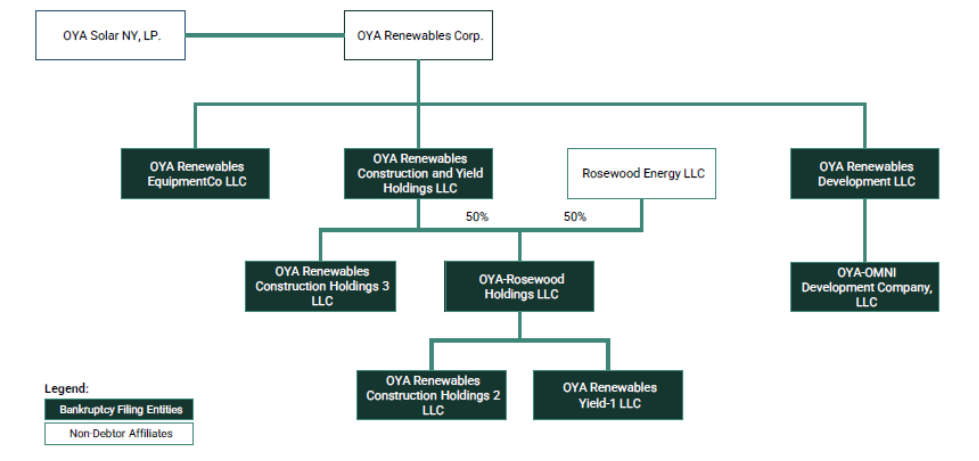
OYA Renewable Construction Holdings 3 LLC (“ORCH 3”) and OYA Renewables Construction Holdings 2 LLC (“ORCH 2”) hold late stage projects. OYA Renewables EquipmentCo LLC (“ORECO”) holds assets like solar panels and transformers. The prepetition Carval lenders have a lien on ORCH 3, ORCH 2, and ORECO.
Then we have OYA Renewables Development LLC (“ORD”) and OYA-OMNI Development Company, LLC. These two “development” affiliates overlook early and mid stage projects. The prepetition GDEV lenders hold a lien on these projects.
Finally, the prepetition City National Bank (“CNB”) facility is secured by assets that sit at OYA Renewables Yield-1 LLC (“ORY-1”).
All of that is important because there’s a stalking horse bidder: Radial Power LLC (“Radial”). But, Radial only wants to acquire assets at three of the debtor entities. Can you guess which ones? Yep, ORCH 1, ORCH 2, and ORECO; the late stage projects and equipment. Those could very well be the most valuable assets the debtors have.
The stalking horse bid includes a cash purchase price of ~$30mm (plus contingent payments totaling $1mm) and the assumption of various liabilities.
The remaining assets not apart of the stalking horse bid will be sold via a continued marketing process led by investment banks, Agentis Capital and SenaHill Partners.**
The debtors are not expecting to generate any revenue during its time in bankruptcy and currently have just $54k in cash. So when your budget looks something like this…

… you definitely need a new money injection. Luckily, the stalking horse bidder, Radial, is coming in with a $6mm new money DIP. The debtors will have access to $3mm on an interim basis and $3mm following a final order.
Obviously, this is a priming DIP. Not too priming though as it only primes $1.5mm of GDEV’s prepetition debt and $4.5mm of Carval’s prepetition debt. The DIP carries an 8% interest rate and a 1.75% upfront fee (earnable on each draw).***
Under the DIP agreement milestones, the debtors will have 60 days to conclude auctions. We’ll see if the leftover assets fetch any significant interest.
The debtors are represented by Sidley Austin LLP (Duston Mcfaul, Maegan Quejada, Nathan Elner, Chelsea McManus, Ian Ferrell) and Young Conaway Stargatt & Taylor LLP (Robert Brady, Edmon Morton, Kenneth Enos, Rebecca Lamb) as legal counsel, Ankura Consulting Group, LLC (John Shepherd) as financial advisor, and Agentis Capital and SenaHill Partners as investment bankers. Radial Power LLC is represented by White & Case LLP (Charles Koster, Amanda Parra Criste) and Ashby & Geddes PA (Ricarda Palacio) as legal counsel.
*Although it is not the current business model, the debtors have in the past also brought projects to completion.
**The debtors had started a prepetition marketing process in February ‘24.
***The DIP won’t need to be paid in cash if Radial is the ultimate successful bidder. Instead it’ll be credited towards the cash purchase price.
☢️ New Chapter 11 Bankruptcy - Ultra Safe Nuclear Corporation ☢️
On October 29, 2024, TN-based Ultra Safe Nuclear Corporation and three affiliates (collectively, the “debtors”) filed chapter 11 bankruptcy cases in the District of Delaware (Judge Owens). The debtors are “a global leader and vertical integrator of nuclear technologies and services, on Earth and in Space,” according to the first-day declaration of interim CEO Kurt A. Terrani. They have also, as we shall see, suffered a dramatic Chernobyl-style meltdown of liquidity after their anchor investor bid farewell to this vale of tears.
Which is odd, isn’t it? Nuclear is enjoying a renaissance: everybody’s talking nukes these days. There’s the ever-increasing possibility of a civilization-canceling nuclear conflagration, of course, but the bigger deal is the gargantuan, prodigious, mammoth supply of power demanded by Artificial Intelligence. Which comes at the worst possible moment, right when we’re shutting down the coal-fired plants and working to ban the sale of internal combustion engines because we’re still (right, guys?) dedicated to Zero-Carbon (let’s see some enthusiasm) by 2040 … and damn it, wind and solar just aren’t there yet. We wrote about this trend: Microsoft ($MSFT) reboots Three Mile Island; data centers are a Big Thing. Nukes are zero-carbon, so Larry Fink says it’s OK for you to deploy some dry powder there. It’s the Nuclear Moment, right?
A moment tailor-made for the debtors, one would think. Founded in ‘11 by Dr Francesco Venneri, former CEO and current chief science officer, the debtors initially sought to commercialize the technology for Fully Ceramic Micro-encapsulated (FCM®) nuclear fuel (“FCM Fuel”), co-invented by Dr. Venneri. They are also developing the Micro Modular Reactor (MMR®) (the “MMR”) along with power and propulsion technologies for the defense industry and space exploration. FCM Fuel looms largest among these projects. “FCM Fuel consists of Tri-structural ISOtropic (“TRISO”) fuel particles embedded inside a silicon carbide matrix.” Just nod your heads, folks.
The debtors have “developed unique and proprietary commercial scale equipment” to produce these sinister yet Gaia-saving globules, much of it housed in their Pilot Fuel Manufacturing Facility in Oak Ridge, Tennessee. The facility was once used by the Manhattan Project, Terrani announces proudly, and is now the “largest commercial-scale TRISO production facility anywhere in the United States.”
Commercial scale? Are we really there yet? Anyway, FCM Fuel is the logical power source for the debtors’ MMR:
Now, just think about the MMR as a “‘nuclear battery,’” with 15.7 billion kilowatt- hours of thermal energy (kWth) during its lifetime,” Terrani writes. The MMR boasts any number of forward-looking features. It’s modular, you can build it with off-the-shelf parts, and it does not require water or an electrical grid or infrastructure. “The MMR’s ability to provide reliable but variable baseload power also makes it an ideal complement to other forms of renewable energy (such as wind and solar) to create new and more efficient renewable micro grids.” In other words: if you’re building a wind/solar plant, make sure you get a MMR for backup power. Nuclear is reliable; the wind and sun are more fickle.
The MMR is currently in the licensing stage with authorities in the U.S., Canada and the U.K. But there’s a lot more FFM Fuel can do besides feed the MMR. It’s suitable for most reactor types. The debtors once created a special version for the National Aeronautics and Space Administration, “…as the agency seeks to develop technologies for nuclear-powered space propulsion.”
That came as a surprise. Who knew NASA was still in the “space exploration” business? Well, Houston, the debtors have you covered. First up is the Nuclear Thermal Propulsion Engine (“NTP”), which uses nuclear fission to heat up a gas, which is then spit through a nozzle to produce thrust. Terrani says it will get astronauts to Mars “significantly faster” than chemical propulsion, “thereby decreasing astronauts’ exposure to cosmic and solar radiation.”
The thing — which bears a suggestive resemblance to the Monolith from Stanley Kubrick’s classic 2001: A Space Odyssey — is a “10-ton class micro reactor that builds on the MMR and FCM Fuel technologies.” This puppy is built for travel too; it is particularly suitable for “off-grid locations” … which is to say, it is “…a viable solution to provide critical energy to defense applications such as the U.S. military’s forward operating bases.” The screenplay writes itself: you and your regiment of Space Grenadiers are underway in your NTP-powered space fleet to some distant galaxy to … defend democracy, or something. The troops gotta have their Netflix and Instagrams. What better to charge those gadgets than a Python or two? The debtors understand the assignment, as the kids say.
All so ultra-cool. “Dream big,” we’re told, and by damn, these debtors did. But sometimes there’s this lag between the dream and when the eagle screams (aka, the conversion of dreams into hard cash). Sure thing, the debtors are “actively engaged” with NASA, the Department of Energy (“DOE”) and the Department of Defense (“DOD”). “However, aside from the Pilot Fuel Manufacturing Facility for production of FCM Fuel and TRISO particles, many of the Debtors’ products are still being developed, and, as a result, the Debtors’ historical revenue is low compared to operating losses.” Well, we were wondering about that “commercial” reference. So how bad is it? In ‘23, the debtor booked $6.15mm of revenue compared to $81.2mm of expenses. In ‘22, revenues were $5.75mm, with operating expenses just short of 10x that, at $53.9mm.
The debtors historically depended on outside investors for funding, Terrani writes. And they were fortunate enough to have found a devoted, motivated and well-heeled backer: Richard Hollis Helms. Maybe he was a science-fiction fan. He sunk some $100mm of equity into the debtor. That equity is held by USNC Investment LLC, a non-operating SPV (“USNC”). Helms, through USNC, also loaned the debtors roughly $24.5mm under a senior secured convertible promissory facility (the “prepetition secured note”), under which $28.2mm of principal and interest remained due as of the petition date.
That’s a lot of money.
Who is this dude?
“Richard Hollis Helms believed in the Debtors’ inventions and their mission to provide reliable and safe zero-carbon energy anywhere.” Note the tense.
The late Richard Hollis Helms, alas.
The U.S. lost a true patriot and hero in March ‘24, but he lived a life that qualifies him as the World’s Most Interesting Man, next to which the likes of Napoleon Bonaparte are but pale caricatures.
That’s the picture painted by Helms, or whoever did his obituary: an “aviator, spy, entrepreneur, mentor, venture capitalist,” he joined the Central Intelligence Agency (“CIA”) as a security guard in the early ‘70s. He parlayed that into a thirty-year hitch at an agency whose blunders, failures and ineptitude — the Bay of Pigs, the Iranian Revolution, the collapse of the Soviet Union, 9/11, Iraq and there is much, much more — should be far better known than they are (as should be, on the flip side, the successes). His fellow agents considered him a “rock star.” But he wanted more, more, more:
"Upon retirement he entered the private sector where he encountered an inflexible corporate structure unable to utilize his skillset. When the agency did not call on his and his colleagues' profound expertise after 9/11, he founded Abraxas Corporation for which he won the 2006 Ernst and Young National Entrepreneur of the Year Award for Emerging Technology. 10 years after it was created, Richard sold Abraxas and started Ntrepid Corporation which is still successfully developing cutting-edge software to save the world."“Save the world,” huh? How’d that go for you and your pals, Helms? Abraxas, you may recall (lol, jk), was an early entrant in the “intelligence contracting” industry — entities created, cynics might say, for the sole purpose of scarfing down the billions made available by the Patriot Act. This is what Ntrepid claims to do: “…managed attribution technology solutions for the national security community.” Well, we did wonder where Helms got his millions, and now we know.
Helms had suffered various illnesses, Terrani writes, so in ‘22, they began working with Citibank NA ($C) to line up another sugar daddy. Citi knocked on the doors of “asset managers, pension funds, utilities, family offices, large IT companies, corporate investment funds, and various other private equity funds.” Plenty of interest, but all contingent on the debtors’ obtaining an anchor investor, Terrani said. They found one, but this investor was unable to raise sufficient funds. A Canadian labor pension fund kicked in $18mm, but that was it. By early ‘24, liquidity, or its absence, was reaching crisis proportions.
Helms had been board chairman. Dr. Venneri served as the board. When Helms died, the debtors reconstituted it: they added three new directors, asked Dr. Venneri to resign (which he did, effective July 31) and appointed Tanneri as Interim CEO on August 2. The new board’s task was obvious: address the liquidity issue. They retained advisors, including Intrepid Investment Bankers LLC (“Intrepid”). The board tasked Intrepid with drumming up the financing to carry them through a sales and marketing process. Intrepid contacted 38 lenders — a process hampered by the debtors’ “lack of operating history, existing capital structure, and lack of traditional working capital collateral” — but nevertheless managed to identify a helpful lender.
Some of Helms’ old pals at Langley, looking to honor the “rock star’s” memory? A CIA front company, some sort of United Fruit Company for the new millennium? No, JMB Capital Partners LLC, which agreed to provide financing of up to $23mm. The package consisted of a $8mm bridge loan and $15mm of new money DIP financing, with $10mm available on an interim basis. The facility bears interest at 14% and carries a 6% exit fee. The $8mm bridge will be rolled up on a 1:1 basis into the DIP. USNC, lender under the prepetition secured note facility, agreed to subordinate the prepetition secured note to the DIP. The debtors also sought the use of cash collateral.
Great, there’s money. Now what?
A sale, of course!
A company called Standard Nuclear Inc. agreed to serve as stalking horse bidder with an offer of $28mm cash for all of the debtors’ assets. That falls just short of covering the $28.2mm owed under the prepetition secured note issued by Helms’ USNC. The only other secured debt is $650k owed Austin Building and Design for construction work. Unsecured debt, amounts due under a convertible promissory note as well as trade claims, landlords and others, stands at $35.9mm. Bid protections include a 5% breakup fee; Standard Nuclear has not, however, sought expense reimbursement.
The debtors obtained all requested relief at the efficient 40-minute first day hearing on October 30, 2024. The sale motion proposes the following milestones:
On November 13, 2024, the office of the United States Trustee appointed a three-member official committee of unsecured creditors (“UCC”). The UCC subsequently retained Seward & Kissel LLP (Robert Gayda, Catherine LoTempio, Andrew Matott) and Potter Anderson & Corroon LLP (Christopher Samis, Jeremy Ryan, Levi Akkerman) as legal counsel. And now we wait to see if they bring some CIA-level bombs to this situation.
The debtors are represented by Young Conaway Stargatt & Taylor LLP (Michael R. Nestor, Matthew B. Lunn, Elizabeth S. Justison, Shella Borovinskaya) as legal; Ankura Consulting Group LLC (Alan Dalsass) as financial advisor and Intrepid Investment Bankers LLC (Lorie Beers) as investment banker. JPM Capital Partners LLC is represented by Norton Rose Fulbright US LLP (Robert M. Kirsh, Francisco Vazquez, Emily Hong) and Morris James LLP (Eric J. Monzo, Jason S. Levin, Christopher M. Donnelly). USNC Investment LLC is represented by Greenberg Traurig LLP (Nathan A. Haynes, Dennis A. Meloro) and stalking horse bidder Standard Nuclear Ltd is represented by Sullivan Hazeltine Allinson LLC (William D. Sullivan) and Nelson Mullins Riley & Scarborough LLP (Peter J. Haley).
📤 Notice📤
Geoffrey Schmitz (Director) joined Solomon Partners from Portage Point Partners.
🍾Congratulations to…🍾
Blank Rome LLP (Josef Mintz, Lawrence Thomas III, Jordan Williams, Ira Herman, Joseph Welch) for securing the legal mandate on behalf of the official committee of unsecured creditors in the Fluid Market Inc. chapter 11 bankruptcy cases.
Genesis Credit Partners LLC (Edward Kim) for securing the financial advisory mandate on behalf of the official committee of unsecured creditors in the HDC Holdings II LLC chapter 11 bankruptcy cases.
Morrison & Foerster LLP (Lorenzo Marinuzzi, Doug Mannal, Theresa Foudy, Benjamin Butterfield, Raff Ferraioli, Darren Smolarski) and Saul Ewing LLP (Lucian Murley) for securing the legal mandate on behalf of the official committee of unsecured creditors in the American Tire Distributors Inc. chapter 11 bankruptcy cases.
Pachulski Stang Ziehl & Jones LLP (Michael Warner, Theodore Heckel, Bradford Sandler, Robert Feinstein) for securing the legal mandate on behalf of the official committee of unsecured creditors in the TGI Friday’s Inc. chapter 11 bankruptcy cases.
Seward & Kissel LLP (Robert Gayda, Catherine LoTempio, Andrew Matott) and Potter Anderson & Corroon LLP (Christopher Samis, Jeremy Ryan, Levi Akkerman) for securing the legal mandate on behalf of the official committee of unsecured creditors in the Ultra Safe Nuclear Corporation chapter 11 bankruptcy cases.
📚Resources📚
We have compiled a list of a$$-kicking resources on the topics of restructuring, tech, finance, investing, and disruption. 💥You can find it here💥.







